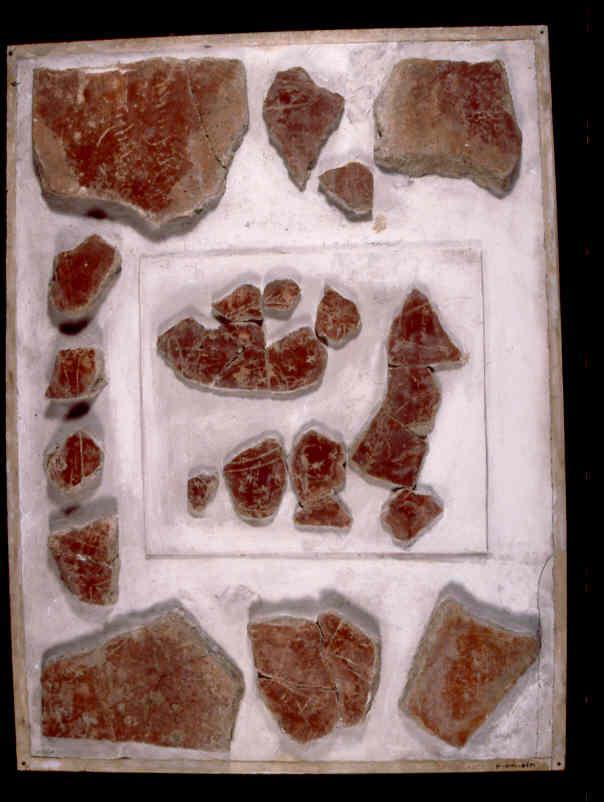(Español) CA2
Reference CLE 1810 | Description | Lyrics | Location | Chronology | Epigraphic edition | Translation | Apparatus | Comentary | Type of verse | Text divided into verses and metric signs | Images | Bibliography | Link to DB | Author |
Description
- Idno filename 22/01/0036
- Type of inscription: Parietalis
- Material Description: Nine fragments unrelated to iconography, together with 19 fragments related to the iconography of a laurel crown around which the texts are distributed. These fragments present inscriptions which have been scratched drypoint on red stucco. The set of 9 does not appear to have anything to do with the set of 19 in terms of text (prose). Nor do they even appear to belong to the same wall (different wall thicknesses).
-
Epigraphic field:
- Layout: The edition follows the order of the fragments mounted on a plaster plaque, from top to bottom, as can be seen in the original drawing by their first editor (LAUMONIER 1919, plate X). In 2013, these plaster fragments were taken off the plaster.
- Decoration: The space inside the crown seems to be decorated with stars, together with some figurative representation that might be a person.
Lyrics
- Font:Capital cuadrada
- Description of the letters:The lettering is square capitals apparently executed by different hands: text a) appears to have been written by a hand 1 which writes a different <T>, <E> and <F> from those of hand 2 in text e). The letter size is unequal from one text to another and even within the same text: text a), between 0.3 and 0.5 (the final <I> in peri, 1: could be longa); text b), 0,4/1; text d), 0,7/1. As regards the description of the letters, to be noted are the <F> of futuisse and frigore, in text a) or of ficos, in text b), with a strong curved foot that is parallel to the writing box; the <B> of habet, in text e), with very unequal lobes, the lower one bigger; <A> and <M>, generally tending to cursive; <G> in text a), highly pronounced caudata; <T> in text e), with a strong foot and curved upper stroke.
Location
- Place of discovery: The fragments were found in excavations from May to June 1918 in what was called house number 2 or “maison du cadran solaire” in Bolonia, Baelo.
- Geolocation
- Conservation location: The fragments are conserved at the MAN
- Inventory number: 1926-15-1083
- Location with Modern Nomenclature España / Cádiz / Bolonia
- Location with Old Nomenclature Hispania / Baetica / Gaditanus / Baelo
Chronology
- Inscription's dating: Between year 101 and year 130
Type of verse
- Type of verse: Dactílico (dístico elegíaco)
- Verse/line correspondence: No
- Prose/verse distinction: No
Epigraphic edition
a)¿‑ ‑ ‑ ‑ ‑ ‑?
[‑ ‑ ‑?]hic eg[o] me mem[i]n[i qu]ondam futuisse puellam
ìn cuiu[s] cunno frig[o]re paene perì
b) [‑ ‑ ‑]us habet f[-1?-]co[‑ ‑ ‑]
5 [‑ ‑ ‑]os [‑ ‑ ‑]mbos
c) [‑ ‑ ‑]us possidet [—]
d) vvas
[‑ ‑ ‑]cluit
Text divided into verses and metric signs
Hic ego me memini quondam futuisse puellam -ww|-/ww|-/ww|-/ww|-ww|-u
in cuius cunno frigore paene peri. –|–|-||-ww|-ww|-
Translation
a) “I remember that here, some time ago, I fucked a girl, in whose cunt I almost froze to death. (...)"
Bibliography
Laumonier 1919, 266–269 (inde Bücheler, CLE 1810); Bonneville – Dardaine – Le Roux 1988, 105 nº 37-43, lám. XXXVII-XLIII (inde HEp 1990, 254); Gómez Pallarès – del Hoyo – Martín Camacho 2005, CA 2, cum im. phot., qui in linguam Hispanicam verterunt; Gómez Pallarès in Fernández Martínez, CLEB, CA2, cum im. phot., qui in linguam Hispanicam vertit; Cugusi 2012, 59. – Cf. Mariner, IHV pp. 190 et 193; Marín Martínez 1957, 115; Cugusi 1980-81b, 14; Gil 1982b, 186–187; Abad 1982, vol. 1, 110. 111. 420. 421; Mayer 1994, 376; Sillières 1995, 35–36; Mayer 1995b, 83; Courtney 1995, 98–99. 308; Cugusi 2003, 460-461; id. 2006, 453; Pardo – Rodríguez 2008, 36; Cugusi 2011b 103.
Apparatus
a) quendam … cunno non dico curiose LAUMONIER 1919; memini[i qu]… puelam (sic) in cuiiu[s]… BONNEVILLE – DARDAINE – LE ROUX. – b) Laumonier def.; [cul]us habet f[i]co[s] … [qu]os ambos BONNEVILLE – DARDAINE – LE ROUX; [- – -]ca / [- – -]us habet f[-ca.1-]co[- – -] / [- – -]os [- – -]mbos GÓMEZ PALLARÈS – DEL HOYO – MARTÍN CAMACHO 2005. – c) Laumonier def.; [cunn]us BONNEVILLE – DARDAINE – LE ROUX; [- – -]us possidet / [- – -]M+[- – -]T[- – -]+ E[- – -]OSR+[- – -]O GÓMEZ PALLARÈS – DEL HOYO – MARTÍN CAMACHO 2005. – d) Laumonier def.; uvas [qu]os BONNEVILLE – DARDAINE – LE ROUX; BONNEVILLE – DARDAINE – LE ROUX differunt editione: putant fragmenta ad unum titulum pertinere; GÓMEZ PALLARÈS – DEL HOYO – MARTÍN CAMACHO 2005 aliter fragmentorum ordinem offerunt.
Comentary
Text a) is the only definitely metrical text, an elegiac distich. From the point of view of typology, the only recognisable text, a), can be placed in the tradition of the erotic texts of Pompeii, for example: e.g., s.n. CLE 955 groups together some Pompeiian inscriptions (= CIL IV, 1516) under the heading of elegiac distich Hic ego nu[nc f]utue(i) formosa(m) fo[r]ma puella(m) / laudata(m) a multis, set lutus intus erat. An exact parallel was given by Calza 1940, 310 (Zarker 1958, 123), Ego memini quenda(m) crissasse puella(m) / cuius cineres aurea terra tegat (crissasse for futuisse: cf. OLD, s.u. criso, with Carm. Priap., 19,4, Telethusa…crisabit tibi fluctuante lumbo).
Author
- Author:J. Gómez Pallarès
- Last Update2023-11-21 10:43:14
- Autopsy date:2001
You can download this





